משתמש:Eranb/ארגז חול 3
מסך ברייל הוא התקן אלקטרו-מכני בו משתמשים עוורים אשר אינם יכולים להשתמש במסך מחשב. המסך מציג תווי ברייל על ידי הרמת נקודות דרך חורים על משטח שטוח. המסך מונח בדרך כלל מתחת למקלדת. עיוורים בדרך כלל משלבים בין שימוש במסך ברייל לשימוש בתוכנת הקראת מסך, בהתאם לנסיבות.

מסכים נפוצים מציגים שורה של 40 או 80 תאי ברייל (כל תא כזה מקביל בדרך כלל לאות אחת), אך ישנם גם דגמים בעלי 18 עד 40 תאים, בעיקר באמצעים המשמשים לרישום הערות קצרות. בחלק מהדגמים מסומן מקום הסמן על ידי הרעדת הנקודות. דגמים מסוימים מאפשרים להעביר את הסמן לתא ספציפי על ידי שימוש במתג המשויך לכל תא. כדי להרים את הנקודות משתמשים באפקט הפיאזואלקטרי - לכל נקודה מותאם גביש, אשר מתרחב בעת שמופעל עליו מתח חשמלי ומזיז מוט אשר דוחף מעלה את הנקודה. תו ברייל יכול להיות מורכב מעד שמונה נקודות (ולא רק שש, כדי לתמוך בכתב ברייל מורחב), כך שנדרשים שמונה גבישים לכל תא.
התוכנה אשר שולטת במסך נקראת קורא מסך. היא אוספת את תוכן המסך הנראה ממערכת ההפעלה, ממירה אותו לתווי ברייל ומעבירה אותו למסך הברייל. קוראי מסך למערכות הפעלה גרפיות הם מסובכים יותר, שכן עליהם לתרגם אלמנטים כמו חלונות וסרגלי גלילה לצורה טקסטואלית עבור המשתמש העיוור. מערכות הפעלה מודרניות מספקות ממשק תכנות יישומים כדי לסייע לקוראי מסך לקבל מידע זה, כמו למשל MSAA בMicrosoft Windows ו-AT-SPI ב-GNOME.
A new development, called the rotating-wheel Braille display, was developed in 2000 by the National Institute of Standards and Technology (NIST) and although a second rotating display was designed by the Leuven University in Belgium[1] both wheels are still in the process of commercialization. Braille dots are put on the edge of a spinning wheel, which allows the user to read continuously with a stationary finger while the wheel spins at a selected speed. The Braille dots are set in a simple scanning-style fashion as the dots on the wheel spins past a stationary actuator that sets the Braille characters. As a result, manufacturing complexity is greatly reduced and rotating-wheel Braille displays will be much less expensive than traditional Braille displays.
History
[עריכת קוד מקור | עריכה]The base of a refreshable braille display is a pure braille terminal. There the input is performed by two sets of three keys plus a space bar (as in the Perkins Brailler), while output is via a refreshable braille display consisting of a row of electromechanical character cells, each of which can raise or lower a combination of six round-tipped pins. Other variants exist that use a conventional QWERTY keyboard for input and braille pins for output, as well as input-only and output-only devices. In 1951, David Abraham, a woodworking teacher at Perkins, created a portable braille terminal.[2]
